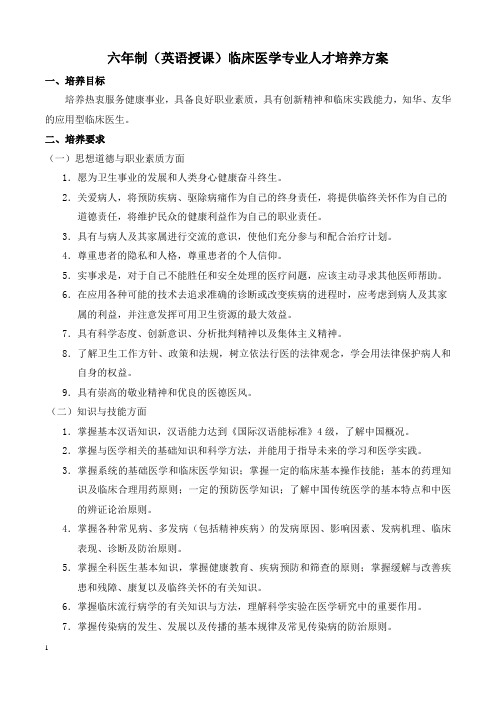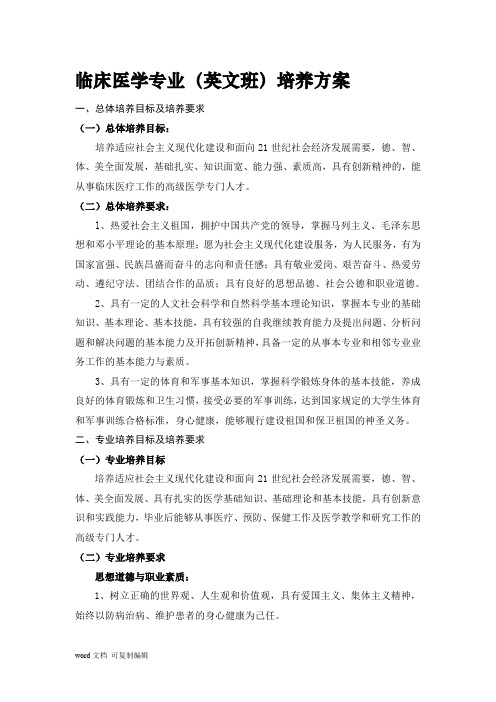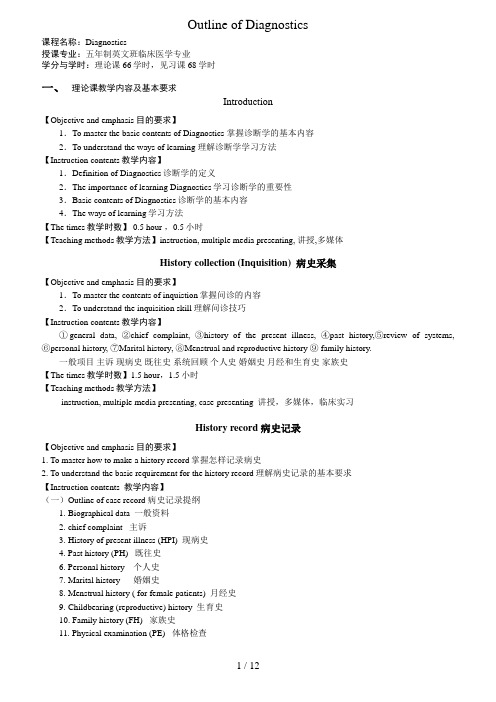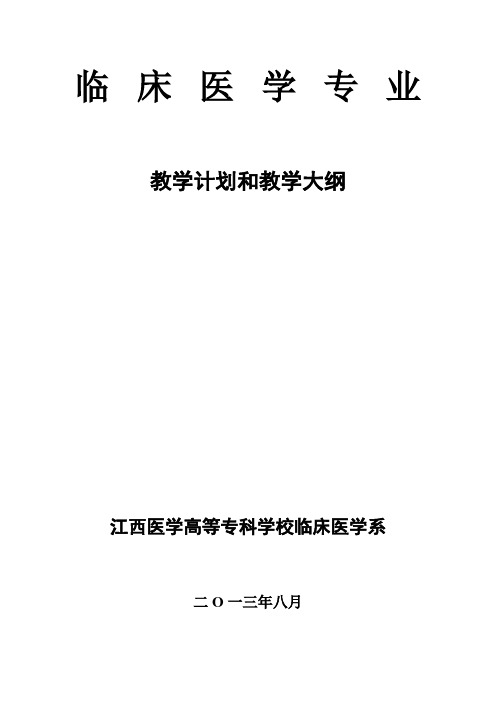临床医学专业(英文班)课程设置与教学进程表
- 格式:xls
- 大小:27.50 KB
- 文档页数:2

六年制(英语授课)临床医学专业人才培养方案一、培养目标培养热衷服务健康事业,具备良好职业素质,具有创新精神和临床实践能力,知华、友华的应用型临床医生。
二、培养要求(一)思想道德与职业素质方面1.愿为卫生事业的发展和人类身心健康奋斗终生。
2.关爱病人,将预防疾病、驱除病痛作为自己的终身责任,将提供临终关怀作为自己的道德责任,将维护民众的健康利益作为自己的职业责任。
3.具有与病人及其家属进行交流的意识,使他们充分参与和配合治疗计划。
4.尊重患者的隐私和人格,尊重患者的个人信仰。
5.实事求是,对于自己不能胜任和安全处理的医疗问题,应该主动寻求其他医师帮助。
6.在应用各种可能的技术去追求准确的诊断或改变疾病的进程时,应考虑到病人及其家属的利益,并注意发挥可用卫生资源的最大效益。
7.具有科学态度、创新意识、分析批判精神以及集体主义精神。
8.了解卫生工作方针、政策和法规,树立依法行医的法律观念,学会用法律保护病人和自身的权益。
9.具有崇高的敬业精神和优良的医德医风。
(二)知识与技能方面1.掌握基本汉语知识,汉语能力达到《国际汉语能标准》4级,了解中国概况。
2.掌握与医学相关的基础知识和科学方法,并能用于指导未来的学习和医学实践。
3.掌握系统的基础医学和临床医学知识;掌握一定的临床基本操作技能;基本的药理知识及临床合理用药原则;一定的预防医学知识;了解中国传统医学的基本特点和中医的辨证论治原则。
4.掌握各种常见病、多发病(包括精神疾病)的发病原因、影响因素、发病机理、临床表现、诊断及防治原则。
5.掌握全科医生基本知识,掌握健康教育、疾病预防和筛查的原则;掌握缓解与改善疾患和残障、康复以及临终关怀的有关知识。
6.掌握临床流行病学的有关知识与方法,理解科学实验在医学研究中的重要作用。
7.掌握传染病的发生、发展以及传播的基本规律及常见传染病的防治原则。
8.具有全面系统正确地采集病史、进行体格及精神检查和规范书写病历的能力。

临床医学专业(英文班)培养方案一、总体培养目标及培养要求(一)总体培养目标:培养适应社会主义现代化建设和面向21世纪社会经济发展需要,德、智、体、美全面发展,基础扎实、知识面宽、能力强、素质高,具有创新精神的,能从事临床医疗工作的高级医学专门人才。
(二)总体培养要求:l、热爱社会主义祖国,拥护中国共产党的领导,掌握马列主义、毛泽东思想和邓小平理论的基本原理;愿为社会主义现代化建设服务,为人民服务,有为国家富强、民族昌盛而奋斗的志向和责任感;具有敬业爱岗、艰苦奋斗、热爱劳动、遵纪守法、团结合作的品质;具有良好的思想品德、社会公德和职业道德。
2、具有一定的人文社会科学和自然科学基本理论知识,掌握本专业的基础知识、基本理论、基本技能,具有较强的自我继续教育能力及提出问题、分析问题和解决问题的基本能力及开拓创新精神,具备一定的从事本专业和相邻专业业务工作的基本能力与素质。
3、具有一定的体育和军事基本知识,掌握科学锻炼身体的基本技能,养成良好的体育锻炼和卫生习惯,接受必要的军事训练,达到国家规定的大学生体育和军事训练合格标准,身心健康,能够履行建设祖国和保卫祖国的神圣义务。
二、专业培养目标及培养要求(一)专业培养目标培养适应社会主义现代化建设和面向21世纪社会经济发展需要,德、智、体、美全面发展、具有扎实的医学基础知识、基础理论和基本技能,具有创新意识和实践能力,毕业后能够从事医疗、预防、保健工作及医学教学和研究工作的高级专门人才。
(二)专业培养要求思想道德与职业素质:1、树立正确的世界观、人生观和价值观,具有爱国主义、集体主义精神,始终以防病治病、维护患者的身心健康为己任。
2、全心全意为人民服务,维护人民和社区健康利益,较好利用可用资源达到康复的最大效益。
3、具有较强人际交往能力,善于与病人、家属、同事等沟通,相互学习,善于合作。
4、树立终生学习观念,追求卓越,并具有在医学某一学科领域内进一步深造的基础。

来华留学生临床医学专业本科(英语授课)教学大纲摘要:一、背景介绍二、教学大纲制定目的三、教学内容与课程设置四、教学方法与评价体系五、实践教学与附属医院资源六、培养质量与发展方向七、结语正文:来华留学生临床医学专业本科(英语授课)教学大纲旨在培养具有国际视野和高素质的医学人才,以满足我国医疗卫生事业发展的需求。
本教学大纲的制定遵循国际医学教育标准,结合我国医学教育实际情况,注重培养学生的临床技能、科研能力、职业道德和人文素养。
一、背景介绍随着全球化的推进,国际交流与合作日益增多,来华留学生教育成为我国高等教育的重要组成部分。
临床医学专业(英语授课)来华留学生的培养,不仅有助于提升我国医学教育国际地位,还能为世界各国输送优秀的医学人才。
二、教学大纲制定目的本教学大纲的制定旨在规范来华留学生临床医学专业本科(英语授课)的教育教学活动,确保培养质量,满足国内外医学人才培养需求。
三、教学内容与课程设置教学内容涵盖基础医学、临床医学、预防医学等多个领域,课程设置充分考虑留学生特点,兼顾中西医学体系,注重学科交叉与综合实践。
四、教学方法与评价体系采用多元化教学方法,如讲授、讨论、案例分析、模拟演练等,评价体系包括形成性评价、终结性评价和过程性评价,全面客观地评估学生学业成绩。
五、实践教学与附属医院资源充分利用附属医院资源,加强实践教学,提高学生的临床操作能力和实际工作能力。
为学生提供实习、实训等机会,增加实践经验。
六、培养质量与发展方向注重培养质量,强化师资队伍建设,加强与国内外医学院校的合作与交流,为学生提供宽广的发展空间。
鼓励学生继续深造,从事医学研究或临床工作。
七、结语来华留学生临床医学专业本科(英语授课)教学大纲的制定与实施,将有力推动我国医学教育国际化进程,为世界医学事业作出贡献。

Outline of Diagnostics课程名称:Diagnostics授课专业:五年制英文班临床医学专业学分与学时:理论课66学时,见习课68学时一、理论课教学内容及基本要求Introduction【Objective and emphasis 目的要求】1.To master the basic contents of Diagnostics 掌握诊断学的基本内容2.To understand the ways of learning 理解诊断学学习方法【Instruction contents教学内容】1.Definition of Diagnostics诊断学的定义2.The importance of learning Diagnostics学习诊断学的重要性3.Basic contents of Diagnostics诊断学的基本内容4.The ways of learning学习方法【The times教学时数】 0.5 hour ,0.5小时【Teaching methods教学方法】instruction, multiple media presenting, 讲授,多媒体History collection (Inquisition) 病史采集【Objective and emphasis 目的要求】1.To master the contents of inquistion掌握问诊的内容2.To understand the inquisition skill理解问诊技巧【Instruction contents教学内容】①general data, ②chief complaint, ③history of the present illness, ④past history,⑤review of systems, ⑥personal history, ⑦Marital history, ⑧Menstrual and reproductive history ⑨ family history.一般项目主诉现病史既往史系统回顾个人史婚姻史月经和生育史家族史【The times教学时数】1.5 hour,1.5小时【Teaching methods教学方法】instruction, multiple media presenting, case-presenting 讲授,多媒体,临床实习History record 病史记录【Objective and emphasis 目的要求】1. To master how to make a history record掌握怎样记录病史2. To understand the basic requirement for the history record理解病史记录的基本要求【Instruction contents 教学内容】(一)Outline of case record 病史记录提纲1. Biographical data 一般资料2. chief complaint 主诉3. History of present illness (HPI) 现病史4. Past history (PH) 既往史6. Personal history 个人史7. Marital history 婚姻史8. Menstrual history ( for female patients) 月经史9. Childbearing (reproductive) history 生育史10. Family history (FH) 家族史11. Physical examination (PE) 体格检查12. Laboratory tests and instrumental examination 实验室检查和仪器检查13. Primary diagnosis 初步诊断(二)Example of case record 病历示范【The times 教学时数】 2 hours ,2小时【Teaching methods 教学方法】 instruction, power point showing, case-presenting 讲授,多媒体,临床实习Common symptoms 常见症状Fever发热【Objective and emphasis 目的要求】1.To master the type of fever and clinical classification掌握发热的类型和临床分类2.To understand the mechanism of fever and etiology理解发热的机制和病因【Instruction contents 教学内容】1.Physiology 生理机制2.Mechanism of fever发热的机制3.Etiology 病因4.Clinical classification:临床分类5.Clinical manifestation临床症状6.Type of fever热型(1)Continuous(continued) fever 稽留热(2)Remittent fever弛张热(3)Intermittent (periodic) fever周期性发热(4)Undulant fever波状热(5)Relapsing (recurrent)fever间歇热(6)Irregular fever不规则发热7.Symptoms and signs of fever发热的症状和体征【The times 教学时数】 2 hour 2小时【Teaching methods教学方法】 instruction, multiple media presenting, 讲授,多媒体Abdominal pain腹痛【Objective and emphasis目的要求】1.To master the contents of abdominal pain掌握腹痛的内容2.To understand the significance of abdominal pain了解腹痛的意义【Instruction contents 教学内容】1.Inquisition technique问诊技巧2.Contents of inquisition for abdominal pain腹痛问诊的内容(1)Where is the pain located? (Site)疼痛的部位?(2)Where does the pain radiate to(referred pain), or does it originate elsewhere and move to the abdomen?疼痛放射到哪里?或疼痛原发于别的部位然后转移至腹部?(3)whar kind of pain is it? (Character)疼痛的性质?(4)How sever is it? (Severity)疼痛的程度?(5)What other symptoms accompany the pain?疼痛伴随哪些症状?(6)What factors bring it about? 什麽原因导致疼痛的发生?(7)What factors cause relief of pain? (Aggravating and Relieving factors) 什麽原因可减轻疼痛?(8)In chronic abdominal pain inquire about the patients’ day. 慢性腹痛的病人要问诊疼痛时间(9)Again in chronic pain it is useful to inquire about the periodicity of the pain. 慢性腹痛的病人问诊疼痛的周期性3.Clinical Significance临床意义【The times 教学时数】 2 hours 2小时【Teaching methods教学方法】instruction, multiple media presenting,讲授,多媒体Cough ,sputum production and dyspnea咳嗽,咳痰和呼吸困难【Objective and emphasis 目的要求】1.To master the causes and mechanism of sputum production and dyspnea掌握痰液产生和呼吸西困难的机制和原因2.To understand the clinical significance of sputum and dyspnea理解痰液产生和呼吸西困难的临床表现【Instruction contents教学内容】1.Definition of cough and dyspnea咳嗽和呼吸困难的定义2.Causes and mechanism病因和机制respiratory disorders呼吸疾病pleural diseases胸膜疾病cardiovascular disorders心血管疾病central nervous system disorders中枢神经系统疾病3.Sputum production痰液产生Transudates漏出液Exudates渗出液Mucus黏液Dusts aspirated吸入灰尘Infracted tissues坏死组织4.Causes and significance of dyspnea呼吸困难的病因和临床表现【The times教学时数】2 hours教学时数 2小时【Teaching methods教学方法】instruction, power point showing, case-presenting讲授,幻灯片,病例分析CHAPTER 1. Basic methods for physical examination 体检的基本方法【Objective and emphasis 目的要求】1.To master the basic methods of physical examination掌握体格检查的基本方法2.To understand the significance of these physical examination理解体格检查的意义【Instruction contents 教学内容】1.Inspection: the definition of inspection and give some examples视诊: 视诊的定义并举例2.Palpation: the definition of palpation and the kinds of palpation, to master the maneuver of palpation and their significance.触诊: 触诊的定义和分类,掌握触诊的方法和意义3.Percussion: the definition of percussion and the kinds of percussion, to master the maneuver and the different sounds produced by percussion.叩诊:叩诊的定义和分类,掌握叩诊的方法和意义4.Auscultation: the definition and the significance of auscultation. Know how to use stethoscope.听诊: 听诊的定义意义.掌握怎样使用听诊器5.Olfactory examination: know some special odors that could provide valuable clues in clinic.嗅诊:掌握一些在临床上提供有意义线索的特殊气味.【The times 教学时数】2 hours 2小时【Teaching methods教学方法】instruction, power point showing讲授,幻灯片CHAPTER 2. General examination 一般检查【Objective and emphasis 目的要求】1.To master the basic methods and the contents of general examination掌握一般检查的基本方法和内容2.To master measurement of the temperature, blood pressure and examination of sequence and maneuver of lymph nodes掌握体温测量,血压测量的方法和淋巴结检查的顺序和方法3.To understand the significance of the physical examination and master the normal and abnormal signs and clinical significance理解体格检查的意义,掌握正常和异常体征及临床意义【Instruction contents教学内容】Vital signs: the normal range and abnormal conditions of Temperature, Blood pressure, Pulse, Respiration. To master measurement of the temperature, blood pressure.生命体征:正常范围,体温血压,脉搏,呼吸的异常情况.掌握体温血压的测量方法Sex:know some sex-related disease such as hemophilia, systemic lupus erythematous.性别:知道哪些性别相关性疾病,如血友病,系统猩红斑狼疮Age年龄Development and habitus: know the judgments about the normal development and three types of habitus.发育和姿势:掌握正常发育和三种姿势Nutrition: how to judge the state of nutrition.营养:怎样判定营养状态State of consciousness: the definition of the Somnolence, Confusion, Stupor, Coma.意识状态:嗜睡,昏睡,木僵和昏迷的定义Position and posture: the three types of position including active position, passive position and compulsive position.体位和体态:主动体位,被动体位,强迫体位Gait步态Facial (features) characteristics: know the abnormal sign and clinical significance about the facial面容特征:掌握异常面容的体征和临床意义如急性面容,慢性面容,肝病面容,甲状腺功能减低面容,满月脸,二尖瓣面容feature such as Acute facial feature, Chronic facial feature, Hepatic face, Hyperthyroidism face, Moon face, Mitral face.Skin: to master the definition of spider angioma and its clinical significance.皮肤:掌握蜘蛛痣的定义和临床意义Edema: the definition and kinds of edema and its significance.水肿:水肿的定义和意义Subcutaneous nodules and hair 皮下结节和毛发Lymphatic node: to master examination of sequence and maneuver of lymph node. Significance of lymphatic node if be palpated.淋巴结:掌握淋巴结检查顺序和方法,可触到的淋巴结的意义【The times教学时数】 2 hours 2小时【Teaching methods教学方法】instruction, power point showing 讲授,幻灯片CHAPTER 3. Head and neck 头颈【Objective and emphasis 目的要求】1.To master the methods and the contents of head and neck examination掌握头颈检查的方法和内容2.To master the significance of the physical examination: especially measurement of sequence and maneuver of carotid artery, jugular vein, thyroid and trachea掌握体格检查的意义:颈动脉,颈静脉甲状腺和气管检查的顺序和方法3.To understand the examination of sequence and maneuver of head理解头部检查的顺序和方法【Instruction contents 教学内容】1.Head: to master the contents of examination of the head and the maneuver of the detection of the cranium, to know certain deformities of the skull, such as头部:掌握头部检查的内容和颅部检查的方法,知道头颅畸形,例如Microcephalus头颅过小Squared skull方型颅Deforming skull畸形颅Oxycephalia (tower skull, steeple skull)尖颅Macrocephalus头颅过大2.Eyes:to master the normal and abnormal signs and their significance in clinic眼:掌握正常和异常体征及其临床意义(1)Eyebrow:眉毛(2)Eyelids眼睑1)Disturbance of closure of the eyelids:眼睑关闭异常2)Ectropion 睑外翻3)Entropin睑内翻4)Eyelid edema 眼睑水肿5)Eyelid ptosis睑下垂(3)Conjunctiva:结膜(4)Eyeball:眼球l)Exophthalmos:眼球突出2)Enophthalmos:眼球内陷3)Eyeball movements眼球运动(5)Sclera:yellow sclera often was seen in jaundice巩膜:巩膜黄染常见于黄疸(6)Cornea:角膜(7)Iris and pupil:虹膜和瞳孔l)Pupillary shape:瞳孔形状2)Pupillary direct and consensual response to light: to master the contents of examination, the maneuver and significance瞳孔光反射:掌握检查的内容,方法和意义3)Convergence and accommodation集合反射4)Functional ocular examinations, including vision (acuity), color sensation:.眼功能检查,包括视力,色觉3.Ears耳4.Nose:to master the examination’s contents, the maneuver and significance of paranasal sinuses鼻:掌握检查内容,方法和意义5.Mouth (Oral cavity)口腔1)Inspect the lips: to know the abnormal signs such as Pallor, Redness, Cyanosis and pigmentation视诊口唇:异常的体征如苍白,紫绀和色素沉着2)Inspect oral mucous membrane: to know the abnormal signs such as Pallor, Redness, Cyanosis and pigmentation视诊口黏膜:掌握异常体征如苍白,红润,紫绀和色素沉着3)Examine the teeth and gingiva (gum): Method for counting the teeth检查牙齿和牙龈:牙齿的计数方法4)The tongue: 舌5)Pharynx and larynx: Method for examining the Pharynx and larynx. To master the Degree of the enlarged tonsil咽喉:咽喉的检查方法.掌握扁桃体肿大的程度6. Neck: to learn the anatomy of the neck and the contents of physical examinations.颈部:掌握颈部的解剖和检查内容1)Cervical vessels: to master the definition and significance of distended cervical vein颈部血管:掌握颈静脉扩张的定义和意义2)Thyroid gland: to master the palpation of the thyroid gland and the degree of thyroid gland enlargement. Know how to describe the thyroid gland when you palpate and auscultate the thyroid gland甲状腺:掌握甲状腺的触诊方法和肿大程度.掌握甲状腺触诊和听诊的描述3)Trachea: to master the contents of examination, the maneuver and significance气管:掌握检查的内容,方法的意义【The times教学时数】 2 hours 2小时【Teaching methods教学方法】 instruction, power point showing, case-presenting.讲授,幻灯片,临床实习CHAPTER 4. Abdominal examination 腹部检查【Objective and emphasis 目的要求】1.To master the markers and the lines of body surface, the areas and important viscera underlying these regions.掌握体表线和体表标志,分区和这些区域的重要内脏器官2.To master inspection, palpation, percussion, auscultation of abdomen. Especially palpation of liver and spleen.掌握腹部的视,触,叩听方法,特别是肝脾触诊3.To understand the symptoms and signs of common abdominal diseases理解常见腹部疾病的症状和体征【Instruction contents 教学内容】1. the markers and the lines of body surface, the areas and inoportant viscera underlying these regions. 掌握体表线和体表标志,分区和这些区域的重要内脏器官2.examination of abdomen腹部检查(1)Inspection: symmetry, abdominal pulsation, shape, scars, sinuses, fistuas, engorged vein, flank haemorrhages, Visible peristalsis.视诊:对称性,腹部搏动,形状,瘢痕,窦道,瘘管,扩张的静脉,胁腹出血,胃肠蠕动波(2)Palpation: direct tenderness and resistance of muscle, rebound tenderness, palpation of liver, spleen, gallbladder, kidney, atrtributes of masse, fluid trills, succusion splash, tender spots of kidney and ureter.触诊:直接压痛和腹壁紧张度,反跳痛,肝脏,脾脏,胆囊,肾脏,包块,液波震颤,振水音,肾脏和输尿管压痛点(3)Percussion: Traube’s space, regions of liver, spleen, bladder and kidney.叩诊:胃泡鼓音区,肝脾,膀胱和肾脏的区域(4)Ascultation: bowel sound abdominal bruits, friction rubs.听诊:肠鸣音和摩擦音3. The symptom and sings of common abdominal diseases: Peptic ulcer diseases and the complications, hepatic cirrhosis and portal hypertention, intestinal obstruction, acute peritonitis, appendicitis.常见腹部疾病的症状和体征:消化性溃疡和并发症,肝硬化和门脉高压,肠梗阻,急性腹膜炎,阑尾炎【The times教学时数】14 hours (Instruction 6 hours, practice 8 hours) 14小时【Teaching methods教学方法】instruction, power point showing ,case-presenting. 讲授,幻灯片,临床实习CHAPTER 5. Physical examination of the thorax 胸部体检【Objective and emphasis 目的要求】1.To master the methods and the contents of thorax examination 掌握胸部体检的方法和内容2.To master the mechanism and clinical significance of tactile fremitus and abnormal percussion 掌握触觉语颤的机制和临床意义3.To understand the physical examination and positive signs of some common pulmonary diseases 了解常见肺部疾病体格检查和阳性体征【Instruction contents 教学内容】1.the markers and the lines of body surface, the areas and imoportant viscera underlying these regions.掌握体表线和体表标志,分区和这些区域的重要内脏器官2.examination of thorax胸部检查(1)Inspection of the lung and pleura肺和胸膜的视诊(2)Palpation of the lung and pleura肺和胸膜的触诊(3)Percussion of the lung and pleura肺和胸膜的叩诊(4)Auscultation of the lung and pleura肺和胸膜的听诊3.The symptom and sings of common respiratory diseases: pneumothorax,emphysema,Pleural effusion, pneumonia常见胸部疾病的症状和体征【The times教学时数】 14hours(Instruction 6 hours, practice 8 hours)14小时(讲授6小时,实习8小时)【Teaching methods教学方法】 instruction, power point showing,case-presenting. 讲授,幻灯片,临床实习CHAPTER 6. Cardiovascular system 心血管系统【Objective and emphasis 目的要求】1.To master the examining sequence and methods of heart,including inspection, palpation, percussion and auscultation.掌握心脏的检查顺序和方法包括: 视,触,叩,听方法2.To master the producing mechanism of heart murmurs and their clinical significance. Mastering the key points of auscultation of heart murmurs and differential diagnosis of physical and pathological heart murmurs.掌握心脏杂音的产生机制和他们的临床意义.掌握杂音听诊的关键点和生理性杂音和病理性杂音的鉴别诊断3.understand the symptoms and sings of common heart diseases .理解常见心脏疾病的症状和体征【Instruction contents 教学内容】1.Heart 心脏Inspection 视诊1)Observing precordium观察心前区2)The location, intensity and scope of normal apical impulse and clinical value of its displacement.正常心尖搏动的部位,强度和范围,异常的临床意义3)Abnormal pulsations in the other areas and their clinical values其他区域的异常搏动和临床意义Palpation触诊1)The location, intensity and scope of normal apical impulse and clinical value of its displacement.正常心尖搏动的部位,强度和范围. 异常的临床意义2)The precordial pulsation’s location and its amplitude, duration and intensity.心前区搏动的部位,强度,持续时间和强度.3)The producing mechanism of thrills and location, intensity and quality of thrills.震颤的产生机制和部位强度和性质4)Pericardial friction rub心包摩擦感Percussion 叩诊1)The percussion method of the heart. 心脏的叩诊方法2)The heart borders and their constituents. 心界大小3)Normal relative dullness of the heart and changing cardiac dullness.心脏的相对浊音界和绝对浊音界Auscultation 听诊It includes rate, rhythm, heart sound, murmur and pericardial friction sound.包括心率,心律,心音,杂音和心包摩擦音1)Auscultatory Valve Areas 听诊瓣膜区2)The producing mechanism of heart sound and differential diagnosis of normal heart sounds(S1 and S2). 心音产生的机制和正常心音的鉴别诊断3)Heart rate and heart rhythm. 心率和节律4)The producing mechanism and characteristics of heart murmurs (Location, timing, quality, radiation, and intensity).心脏杂音的产生机制和性质(部位,时期,性质,放射和强度)5)The producing mechanism and its clinical values of pericardial friction rub.心包摩擦音的产生机制和临床意义2.Blood Vessels 血压1)The arterial pulse and its rate, rhythm, intensity and tension.动脉脉搏和频率,节律,强度和张力2)The producing mechanism and characteristics of wave forms (Water hammer pulse, Pulsus alternans, Dicrotic pulse, Paradoxical pulse)波形的产生机制和性质(水冲脉,交替脉,重搏波,奇脉)3)The measurement of arterial pressure and its significance.血压测量的方法和意义4)Pistol-shot sound and Duroziez's sign.枪击音和Duroziez's征3.Common symptoms and signs of cardiovascular diseases: mitral stenosis,mitral imcompetece,aortic incompetence,aortic stenosis,pericardical effusion.心血管疾病的常见症状和体征:二尖瓣狭窄, 二尖瓣关闭不全,主动脉瓣狭窄, 主动脉瓣关闭不全【The times教学时数】14 hours.(Instruction 6 hours, practice 8 hours)14小时(讲授6小时,实习8小时)【Teaching methods教学方法】 instruction, power point showing,case-presenting.讲授,幻灯片,临床实习CHAPTER 7. Physiological and pathological reflex生理和病理反射【Objective and emphasis 目的要求】1.To master the methods of physiological and pathological reflex掌握生理和病理反射的方法2.To understand the significance of the physical examination理解体格检查的意义【Instruction contents 教学内容】1.Superficial reflex: 浅反射(1)corneal reflex,角膜反射(2)plantar reflex,跖反射(3)abdominal reflex, 腹壁反射(4)cremasterie reflex: 提睾反射(5)Eanal reflex2.Deep reflexes: 深反射(1)biceps reflex, 肱二头肌反射(2)triceps reflex, 肱三头肌反射(3)brachioradialis reflex,桡骨膜反射(4)ankle jerk. 跟腱反射(5)knee jerk. 膝腱反射3.Clonus:阵挛(1)Ankle clonus: 踝阵挛(2)Patellar clonus: 髌阵挛4.Pathological reflex病理反射(1)Babinski's sign:.巴氏征(2)Oppenheim's sign: 奥本海姆征(3)Hoffmann’s sign:.霍夫曼征5. Signs of meningeal irritation脑膜刺激征(1)Neck rigidity: 颈项强直(2)Kernig's sign:克氏征(3)Brudzinski's sign: 布氏征【The times教学时数】 1.5 hour 1.5小时【Teaching methods教学方法】instruction, power point showing, case-presenting. 讲授,幻灯片,实习Laboratory Examination实验室检查CHAPTER 1. Stool Routine Test 大便常规【Objective and emphasis 目的要求】1.To master the methods of stool routine test掌握大便常规的方法2.To master the significance of the changes of stool property and the occult blood test掌握大便性状改变的意义和隐血实验的意义3.To understand the significance of microscopic examination理解显微镜检查的意义【Instruction contents教学内容】1.General property of stool大便的一般性状(1)watery stool: 水样便(2)mucus stool: 黏液便(3)pyohemochezia stool:脓血便(4)hematochezia stool: 血便(5)melena or tarry stool: 黑便或柏油样便2.Microscopic examination显微镜检查(1)Cells: 细胞(2)WBC 白细胞(3)RBC红细胞(4)macrophage:normal巨噬细胞(5)tumor cell肿瘤细胞(6)Food residue:食物残渣(7)Ovum of parasite 寄生虫卵3.Occoul blood test隐血实验【The times教学时数】 0.5 hour 0.5小时【Teaching methods教学方法】Instruction, power point showing. 讲授,幻灯片CHAPTER 2. Urine Routine Test 小便常规【Objective and emphasis 目的要求】1.Master the methods of urine routine test掌握尿常规的方法2.Master the significance of the changes of urine property掌握尿液性状改变的意义3.Understand the significance of microscopic examination理解显微镜检查的意义.【Instruction contents 教学内容】1.Sample’s collection and sending标本采集和送检2.General property一般性状(1)Urine volume尿量(2)Color颜色(3)Smell气味(4)Urine Ph尿PH(5)Urine Specific Gravity尿比重3.Chemical tests化学实验(1)protein test蛋白检测(2)Glucose:糖(3)Ketones酮体(4)Bilirubin胆红素(5)Urobilinogen尿胆原(6)Blood血(7)Urinary Nitrites尿硝酸盐4. Microscopic examination显微镜检查(1)Cells细胞(2)Casts管形(3)Pathogenic organism病原微生物(4)Addis count爱迪计数(5)Cell excretion per hour每小时细胞沉渣【The times教学时数】 2 hours 2小时【Teaching methods教学方法】Instruction and powerpoint showing. 讲授,幻灯片CHAPTER 3. Examination of Blood 血液检查【Objective and emphasis 目的要求】1.To master the methods of red blood cell count (RBC)and hemoglobin(Hb) concentration determination.掌握红细胞计数和血红蛋白浓度测定的方法2.To mater the the methods of white blood cell count(WBC) and differentiate count(DC).掌握白细胞计数和分类的方法3.To master the reference values of RBC,Hb,WBC and DC.掌握RBC,Hb,WBC and DC.的参考值4.To master the singnificance of changes of RBC, Hb, WBC and DC.掌握RBC,Hb,WBC and DC.变化的意义5.To understand the significance of RBC and WBC in some common hematological diseases.理解常见血液疾病的意义【Instruction contents教学内容】1.Blood routine test (BRT)血常规检测(1)Red blood cell count(RBC) and Hemoglobin(HB) concentration determination红细胞计数和血红蛋白浓度测定1)The physiological functions of RBC and HB红细胞和血红蛋白的生理功能2)The referential values of RBC and HB红细胞和血红蛋白的参考值3)The clinical significance of RBC and HB红细胞和血红蛋白的临床意义(2).Total white blood cell count (WBC) and Leukocyte differential count (DC)白细胞计数和分类计数4)The morphology of WBC白细胞的形态5)The referential values of WBC and DC白细胞计数和分类计数的参考值6)The clinical significance of WBC and DC白细胞计数和分类计数临床意义2.Special Investigations in hematological diseases血液病的特殊检查(1)Reticulocyte count (RC)网帜红细胞计数1)The referential values of RC网帜红细胞参考值2)The clinical significance of RC网帜红细胞临床意义(2)Hematocrit (Hct)红细胞比容(3)Erythrocyte sedimentation rate (ESR)红细胞沉降率1)The referential values of ESR红细胞沉降率参考值2)The clinical significance of ESR红细胞沉降率临床意义【The times 教学时数】4 hours 4小时【Teaching methods教学方法】 instruction, power point showing. 讲授,幻灯片CHAPTER 4. Liver Function 肝功能【Objective and emphasis目的要求】1.To master the contents of liver function test掌握肝功能检测的内容2.To master the significance of the liver function test 掌握肝功能检测的意义【Instruction contents教学内容】1.Markers of hepatic synthetic capacity 肝脏合成能力的指标(1)Serum proteins:Serum total protein A, G血清蛋白(2)Electrophoresis of serum protein 血清蛋白电泳(3)Prothrombin time(PT)凝血酶原时间2.Tests of bilirubin metabolism 胆红素代谢的检测3.Markers of cholestasis胆汁淤积的标志(1)Alkaline phosphatase (ALP)碱性磷酸酶(2)Gamma-glutamyl transpeptidase (GGT) 谷光酐酞转移酶4.Markers of hepatocellular necrosis肝细胞坏死的(1)Hepatic enzymes: ALT,AST, 肝细胞酶5.Test for hepatic carcinoma肝癌检测(1)Alpha-fetoprotein(AFP)6.Detectiion of hepatic viruses肝病毒检测(1)Hepatitis A:甲(2)Hepatitis B:乙(3)Hepatitis C:丙7.Case analysis病例分析【The times教学时数】 3.5 hours 3.5小时【Teaching methods教学方法】 instruction, power point showing, case-presenting. 讲授,幻灯片CHAPTER 5. Renal function 肾功能【Objective and emphasis 目的要求】1.Master the contents of renal function掌握肾功能的内容2.Master the significance of the renal function tests掌握肾功能检测的意义【Instruction contents 教学内容】1.Review of the renal function肾功能2.Endogenous creatinine clearance rate内源性肌酐清除率3.plasma creatinine level血浆肌酐水平4.β2-microglobulin β2微球蛋白5.α1-microglobuliu.α1微球蛋白6.The specific gravity特殊比重【The times 教学时数】 2 hours 2小时【Teaching methods 教学方法】Instruction and powerpoint showing 讲授,幻灯片CHAPTER 6. Examination of Hemorrhagic Disorders 出血疾病的检测【Objective and emphasis目的要求】1.To master both the the reference values and the clinical significance of platelet count(PC),coagulation time(CT)and prothrobin time(PT).掌握血小板计凝血时间和凝血酶原时间的参考值和临床意义2.To understand both the mechanism and the significance of hemostasis,coagulation and anti-coagulation.理解止血, 凝血和抗凝血的机制和意义【Instruction contents 教学内容】1.Mechanism of hemostasis凝血机制(1)Blood vessel血管(2)Platelet 血小板(3)Coagulation factors凝血因子2.Mechanism of coagulation凝血机制3.Anti-coagulation system抗凝血系统4.Tests for hemorrhagic diseases出血疾病(1)Tests of the vascular and platelet phases:Bleeding time (BT),PC出血时间(2)Tests of coagulation phase:CT,Activated partial thromboplastin time(APTT),PT,Thrombin time (TT)(3)Tests for DIC:The Screening tests,the further tests初筛实验,确诊实验【The times教学时数】2 hours 2小时【Teaching methods教学方法】 instruction, power point showing, case-presenting. 讲授,幻灯片,实习CHAPTER 7. Examination of bone marrow骨髓的检测。

临床医学专业教学计划和教学大纲江西医学高等专科学校临床医学系二O一三年八月目录临床医学专业教学计划 ......................................... 人体解剖学和组织胚胎学 ..................................... 生理学 ..................................................................... 生物化学 ................................................................. 病原生物与免疫学 ................................................. 病理学及病理生理学 ............................................. 药理学 ..................................................................... 机能学实验教学大纲 ............................................. 预防医学 ................................................................. 诊断学 ..................................................................... 内科学 ..................................................................... 外科学 ..................................................................... 妇产科学 ................................................................. 儿科学 ..................................................................... 传染病学 ................................................................. 精神病学 ................................................................. 眼耳鼻咽喉科学 ..................................................... 皮肤病与性病学 ..................................................... 中医学概论医学心理学 ............................................................. 临床早期见习 ......................................................... 社区服务中心见习 ................................................. 护理常用技术实训 ................................................. 外科技能实训 .........................................................临床医学专业教学计划一、培养目标及培养要求培养目标:培养德智体美全面发展的、适应我国经济社会发展特别是医疗卫生事业发展需要的、具有良好职业素质的初级医生。

英语专业医学英语方向教学计划(20XX年5月修订,从20XX级开始实施)一、培养目标本专业培养适应我国二十一世纪外语学科发展和人才培养需要的,具有扎实的英语语言基础知识和语言综合应用能力,具有一定的医学知识与技能,德、智、体全面发展的高素质应用型、复合型专门人才。
二、培养要求1、热爱祖国、热爱社会主义、拥护中国共产党的领导,努力学习马克思主义、毛泽东思想、邓小平理论和“三个代表”重要思想;树立科学发展观,有敢于怀疑、敢于分析批判的精神,有运用科学思维对事物进行研究的态度;遵纪守法,品行端正,在职业活动中坚持原则,开拓进取,全心全意为人民服务。
2、具有较广泛的社会科学、自然科学知识和良好的思想道德素质、文化素质、业务素质、身体素质和心理素质。
3、具有熟练使用计算机进行英汉语言文字处理、网络资源利用以及从事实际工作和研究的能力;具备一定科研方法和能力。
4、具有扎实的英语语言基础和熟练的听、说、读、写、译等综合能力;具备熟练运用医学英语进行口译和笔译的能力。
5、了解我国国情,熟悉中国文化传统,具有较多的人文知识、科技知识以及一定的艺术修养。
6、熟悉英语国家的地理、历史、发展现状、文化传统、风俗习惯等,具有较强的跨文化交际能力,具备对文化差异的敏感性、宽容性以及处理文化差异的灵活性。
7、掌握基础医学、临床医学的基础理论与知识,掌握医学相关的英语词汇,能读懂各类医学英语文献,熟悉各类医学文体,具备较强的医学英语写作能力。
8、具备一定的获取知识的能力、逻辑思维与独立思考能力,养成运用所学知识独立进行研究和工作的能力。
9、掌握文献检索、资料查询及运用现代信息技术获得相关信息的基本方法,并具有一定的科研能力。
10、掌握一门第二外语,具有一定的第二外国语实际应用能力。
三、业务培养要求(一)专业知识要求1、了解我国国情,熟悉中国文化传统,具有较多的人文知识、科技知识以及一定的艺术修养。
2、熟悉英语国家的地理、历史、发展现状、文化传统、风俗习惯等,具备对文化差异的敏感性、宽容性以及处理文化差异的灵活性。
来华留学生临床医学专业本科(英语授课)教学大纲
摘要:
一、引言
二、课程目标
三、课程设置与学时分配
四、课程内容
1.基础课程
2.专业课程
3.临床实践课程
五、教学方法与考核方式
六、课程管理与师资队伍
七、附则
正文:
【引言】
来华留学生临床医学专业本科(英语授课) 教学大纲旨在为留学生提供高质量的医学教育,培养具备良好医学素质和临床技能的医学人才。
本文详细介绍了课程目标、课程设置与学时分配、课程内容、教学方法与考核方式、课程管理与师资队伍等内容。
【课程目标】
本课程旨在培养留学生掌握临床医学基本理论、基本知识和基本技能,具备良好的职业素养、团队合作精神和创新意识,能够在毕业后从事临床诊疗、
预防保健、医学教育和科研等工作。
【课程设置与学时分配】
课程设置分为基础课程、专业课程和临床实践课程。
其中,基础课程占总学时的40%,专业课程占30%,临床实践课程占30%。
具体课程及学时分配如下:
【课程内容】
1.基础课程:包括解剖学、生理学、生物化学、病理学、药理学、微生物学等课程。
2.专业课程:包括内科学、外科学、妇产科学、儿科学、眼科学、耳鼻喉科学等课程。
3.临床实践课程:包括临床实习、社区卫生服务实习、临床技能培训等。
【教学方法与考核方式】
采用讲授、讨论、实验、实习等多种教学方法,注重培养学生的实践能力和创新能力。
考核方式包括平时成绩、期末考试和实践考核等。
【课程管理与师资队伍】
课程由具备丰富教学经验和临床实践经验的教师团队负责,实行课程负责制和教学质量监控制度,确保课程的高质量实施。
---------------------------------------------------------------最新资料推荐------------------------------------------------------临床医学专业(五年制)教学进程表临床医学专业(五年制)教学进程表培养目标:临床医师修业期限:五年计划修订时间:2019 年 7 月学期序号课程名称考核方式学分学时数合计开课门数考试门数考查门数总计理论实践课外学时学分周学时一 1 思想道德修养与法律基础查 342 20 8 14 总:454 26.5 26.7 9 3 6 2 中国近现代史纲要查 2 28 20 4 4 理:298 3 体育Ⅰ 查 0.5 16 0 16 实:114 4 英语Ⅰ 试 4.5 70 70 0 外:42 5 军事理论查 2 32 8 0 24 6 医用基础化学试 5.5 100 68 32 7 人体系统解剖学试 5 108 54 54 8 高等数学(限选) 查 2.5 36 36 0 9 医学导论(限选) 查1.5 22 22 0 二 1 马克思主义基本原理概论试 3 42 28 104 总:466 25.5 27.4 9 5 4 2 形势与政策Ⅰ 查 1 14 4 0 10 理:286 3 体育Ⅱ 查 1 32 0 32 实:166 4 英语Ⅱ 查 4 60 60 0 外:14 5 计算机应用试 4 80 44 36 6 生物化学试5 76 76 07 生物化学实验查 1.5 48 0 48 8 细胞1 / 5生物学试 2 36 24 12 9 组织胚胎学概论# 试 4 78 50 28 三 1 查 6 84 56 14 14 总:478 27.5 28.1 11 4 7 2 形势与政策Ⅱ 查 1 14 4 0 10 理:328 3 体育Ⅲ 查 0.5 16 0 16 实:126 4 英语Ⅲ 试 4.5 70 70 0 外:24 5 病原生物学与免疫学实验查 1.5 52 0 52 6 机能实验学Ⅰ 查 1 32 0 32 7 生理学试 4.5 70 70 0 8 医学免疫学试 2 32 32 0 9 医学微生物学试 3 46 46 0 10 寄生虫学(限选) 查 1.5 22 22 0 11 医用物理学(限选)查 2 40 28 12 四 1 体育Ⅳ 查 1 32 0 32 总:430 22 25.3 7 5 2 2 英语Ⅳ 查 5 80 80 0 理:252 3 病理生理学试 3.5 54 54 0 实:178 4 病理学试 5 98 54 44 5 机能实验学Ⅱ试 2 62 0 62 6 人体局部解剖学试 1.5 40 0 40 7药理学试 4 64 64 0 临床医学专业(五年制)教学进程表培养目标:临床医师修业期限:五年计划修订时间:2019 年 7 月学期序号课程名称考核方式学分学时数合计开课门数考试门数考查门数总计理论实践课外学时学分周学时五 1 英语Ⅴ 查 2 32 32 0 总:459 24 27.0 13 7 6 2 流行病学查 1.5 28 16 12 理:---------------------------------------------------------------最新资料推荐------------------------------------------------------290 3 卫生学试 2.5 47 32 15 实:169 4 医学统计学试 2 36 24 12 5 医学形态实验学查 1 28 0 28 6 实验诊断学试 3 54 36 18 7超声学查 1 20 16 4 8 临床诊断学试 3.5 72 44 28 9 外科学(总论)试 2 30 30 0 10 医学影像学试 2.5 4428 16 11 外科手术学试 1 36 0 36 12 医学英语Ⅰ(限选) 查 1 16 16 0 13 微生态学(限选) 查 1.0 16 16 0 六 1 医学伦理学试 2 32 32 0 总:404 23.5 23.8 8 5 3 2 交流技能查 1 16 16 0 理:340 3 循证医学试 1.5 24 24 0 实:64 4 传染病学查 2 40 28 12 5 内科学试 7120 100 20 6 神经精神病学试 3 54 42 12 7 外科学(各论)试 6 102 82 20 8 医学英语Ⅱ (限选) 查 1 1616 0 七 1 人文基础查 1 16 16 0 总:440 25 25.9 15 4 11 2 社会医学试 1 16 16 0 理:332 3 卫生法规试 1 16 16 0 实:104 4 就业指导查 1 20 16 0 4 外:4 5 医学心理学查 2 32 28 4 6 儿科学试3.5 57 48 9 7 耳鼻咽喉科学查 1.5 24 16 8 8 妇产科学试 4 69 54 15 9 核医学查 1.5 26 22 4 10皮肤性病学查 1.5 24 16 8 11 眼科学查 1.5 24 16 83 / 512 中医学查 2.5 48 36 12 13 临床技能培训查 1 36 0 36 14 医学英语Ⅲ (限选) 查 1 16 16 0 15 法医学(限选) 查 116 16 0 临床医学专业(五年制)教学进程表培养目标:临床医师修业期限:五年计划修订时间:2019 年 7 月学期序号课程名称考核方式学分学时数合计开课门数考试门数考查门数总计理论实践课外学时学分周学时课程总时数(学分) 必修 161.5 29311938 909 84 26.3 72 33 39 限选 12.5 200 188 12 0 八九 1 内科学实习(12 周) 12 480 0 480 总:1920 48 40 2 外科学实习(12 周) 12 480 0 480 实:1920 3 妇产科学实习(6 周) 6 240 0 240 4 儿科学实习(6 周) 6 240 0 240 5 神经内科实习(6 周) 6240 0 240 6 门诊实习(6 周) 6 240 0 240 实习总时数 48 1920 0 1920 十 1 选修课程 10 160 160 0 2 选科实习 10 600 0 600 3 选做科研 10 600 0 600 综合强化总学时 10 600 0 600 教学计划总学时(学分)232 5651 2126 3441 84 注:1、选修课包括:限选课程、任选课程和第十学期综合强化课程,必须取得 30学分。